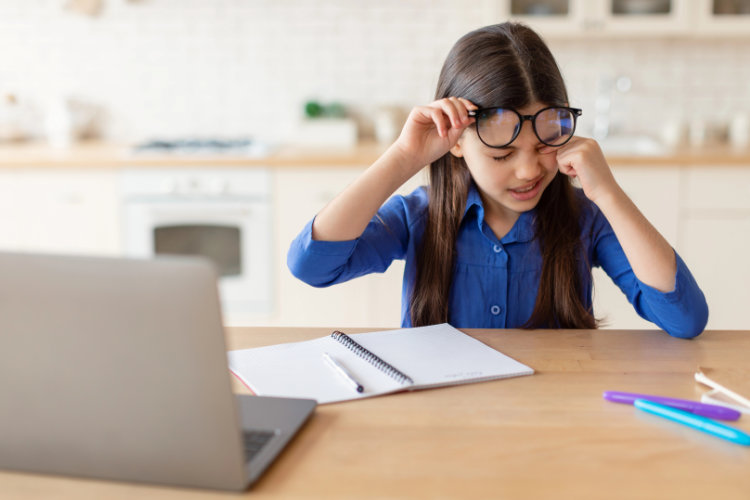New study: Can the air around schools increase the risk of myopia in children?
Myopia is becoming a “silent epidemic” in schools across Asia. According to the latest warning from the World Health Organization (WHO), 80 - 90% of children in Asia, including Vietnam, may be affected by myopia by 2050. In Vietnam, myopia is one of the most common refractive errors among school-aged children, with prevalence rates ranging from 20 - 40% in urban areas and 10 - 15% in rural regions.
Beyond genetic and lifestyle factors, scientists are increasingly paying attention to another critical but often overlooked factor: air quality. A study published in PNAS Nexus (2025) revealed a remarkable association between air pollution and children’s visual acuity. By analyzing data from nearly 30,000 students in Tianjin, China, using advanced explainable machine learning models, the research team discovered that lower ambient concentrations of two major pollutants: nitrogen dioxide (NO2 ) and fine particulate matter (PM2.5), were independently associated with better uncorrected visual acuity (UCVA) in children
UCVA (Uncorrected Visual Acuity) measures the eye’s ability to see clearly without corrective lenses or surgical adjustments.
👀 Air Pollution: The Invisible Threat To Children’s Vision
Air pollution not only damages the lungs and heart, but also directly affects the surface and structure of the eye.
Both NO2 and PM2.5 are hypothesized to contribute to increased oxidative stress and ocular surface inflammation This chronic inflammatory pathway may, in turn, accelerate the progression of myopia.
Notably, primary school students, whose visual systems are still rapidly developing, are the most vulnerable to these negative effects but also the most capable of recovery.
📊 Clean Air Brings the Greatest Benefits to School-Aged Children
The study’s most significant finding is that the positive effects of clean air are not equal across all age groups and myopia severity levels.
| Group | Study Findings | Implications |
| Primary school | When simulating a reduction in PM2.5 and NO₂ levels, the average UCVA of this group improved by approximately 0.09 units, which is twice the average improvement observed across all students. | This is the golden period for protecting children’s vision. Young eyes are highly sensitive to pollution but also more capable of recovery when air quality improves. |
| Mild to moderate myopia (School Myopia) | Vision in this group is significantly affected by modifiable factors (including environment and lifestyle), accounting for roughly 25% of the total myopia risk. | Reducing air pollution is a practical, modifiable environmental measure that can help slow myopia progression in its early stages. |
| Severe myopia (High Myopia) | Vision in this group is largely determined by non-modifiable factors (such as parental myopia, age, and sex), accounting for up to 81% of total myopia risk. | Environmental interventions have limited impact on mitigating the primary risk factors in advanced myopia cases, though they still support overall ocular health. |
🏫 Schools: Where Clear Vision Begins
Children spend more than 10 hours a day at school, making air quality in and around school campuses a critical factor in their physical and cognitive development. Solutions such as indoor air purifiers in classrooms, establishing low-emission “clean-air zones” around schools, or implementing car-free pick-up times not only improve air quality, but also protect children’s vision, enhance concentration, and support long-term learning performance.
🌏Clean Air Today – Clear Vision Tomorrow
A collaborative study by Tianjin Medical University and the University of Birmingham confirmed that clean air is a modifiable and actionable health determinant. Improving air quality in schools is not just a public health initiative. It is a long-term investment in education. A cleaner environment helps students develop more holistically, allows teachers to reduce fatigue and teach more effectively, and reflects a school’s vision and responsibility toward its community.
At IQAir, we believe that every breath of clean air lays the foundation for a healthier, more enlightened generation.
Our proprietary HyperHEPA filtration technology removes up to 99.97% of ultra-fine particles - even those smaller than viruses, delivering the purest air possible to classrooms, libraries, laboratories, and common learning areas.
With IQAir, schools are more than places of education, they are spaces that nurture health, intellect, and the future.
Source: Chen, X., Dai, Y., Wei, R., Du, B., Lu, C., MacKenzie, A. R., ... & Yan, H. (2025). Benefits of clean air for school children's vision health. PNAS Nexus, 4(9), pgaf279.

